Categories
Subjects
Authors
Artists
Venues
Locations
Calendar
Filter
Done
May 28, 2020 – Review
“Metro Pictures Online Film Festival”
Anthony Hawley

It might be a stretch to call an online screening program of gallery artists a “film festival,” just as it might be a leap to describe an online viewing room as an “exhibition.” But “Metro Pictures Online Film Festival” offer its viewers something that resonates in our infinitely streamable world: a series of reckonings with time out of joint and objects out of place. Time capsules, time travel, and temporal transformations abound in works exploring the brevity of life and our troubled relationship to the past.
“I suggest we change the function of this building!” declares a character in David Maljković’s Scene for a New Heritage (2004), the title work in a trilogy featured in the festival. The building in question is the Monument to the Uprising of the People of Kordun and Banija in the Petrova Gora mountain range in Croatia, to which the film’s three protagonists have pilgrimaged as part of their “quest for heritage” in the year 2045. The characters’ reality, symbolized by the tin-foil-covered cars they drive, doesn’t match up with the grandiose future promised by Vojin Bakić’s glittering postmodernist monument, one in a series of towering Croatian spomeniks commemorating revolutions and uprisings against fascism during …
May 23, 2017 – Feature
New York City Roundup
Orit Gat
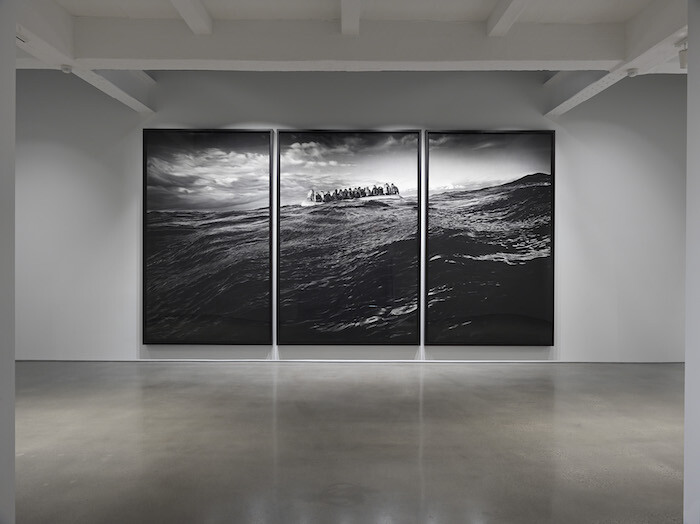
As I missed out on international art events this season because New York is so far away, all I could think of was how unlucky their curators are. You work on Venice or Documenta for a year or two or four. You start out researching when there’s a somewhat liberal president in the US and some island off the coast of Europe still considers itself part of the union. Though the war in Syria, the refugee crisis, and economic instability in the EU were already present, there’s still a feeling that this past year has served too many blows. And those large-scale exhibitions, years in the making, all opened to a great unknown.
On Instagram, almost all the photos I see from Venice are of the same works, and I wonder how and if they respond to the current situation, whether there is a way for art not to seem detached. In New York, few of the exhibitions currently on view in commercial galleries and museums focus directly on contemporary politics. At Metro Pictures, Robert Longo’s show, “The Destroyer Cycle,” does just that. It’s comprised of large-scale charcoal-and-graphite drawings of riot cops in full gear, prisoners being led to a CIA …
April 13, 2017 – Review
“Sputterances”
Tim Gentles
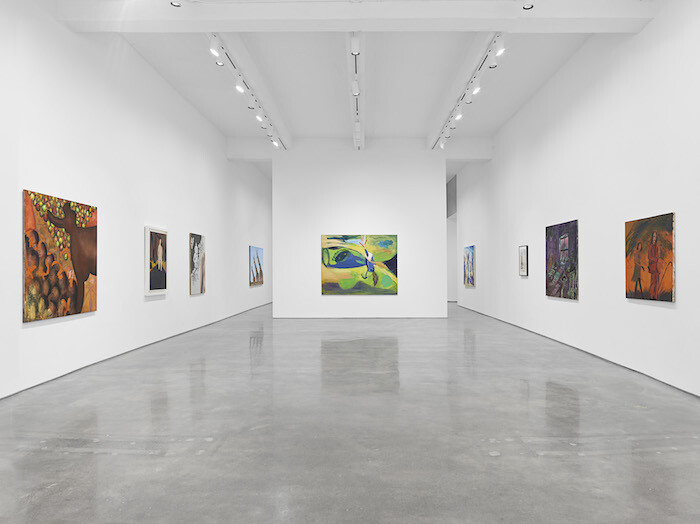
In artist Sanya Kantarovsky’s latest curatorial venture, an exhibition at Metro Pictures organized around the underappreciated Dutch painter René Daniëls, he continues to examine the mechanics of artistic positioning. Similarly, in his previous curated exhibition, “No Joke” at Tanya Leighton (Berlin, 2015), he grouped together work that, through humor and self-deprecation, cast a self-reflexive eye on the mythologization of the artist.
Daniëls, who suffered a cerebral hemorrhage in 1987 at the age of 37, and has only made work sporadically since, was initially received as a Neo-Expressionist, a movement known more for the expulsion of sweat and blood onto canvas than critique of the broader art field. Yet Daniëls’s work—and the present exhibition, whose title “Sputterances,” a portmanteau of sputter and utterance, derived from a poem written by the artist—suggests that this is hardly a neither/nor proposition, and that, rather, expression is tied to the mutual dependence of sense and nonsense, central to which is the question of the frame.
For “Sputterances,” Kantarovsky has assembled 22 artists, ranging from his peers, elder statespeople of figurative painting’s seemingly perpetual renewal, and historical figures both vaunted and obscure, alongside three works by Daniëls. It’s not immediately clear what unites these artists, much less around …
October 7, 2015 – Review
Trevor Paglen
Laura McLean-Ferris
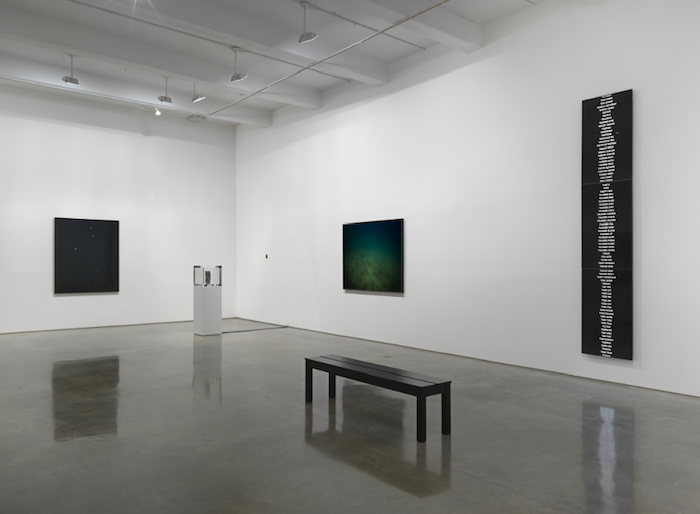
The evidence that we live in a dystopia is mostly swept out of sight, and kept out of mind. So let’s be clear that Trevor Paglen is engaged in a form of politically urgent visual labor. His work, most notably in photography, has given visual texture to a very real, and very menacing, shadow-realm. Lush, compelling images dramatize his near-failure to photograph post-9/11 black sites used for extraordinary rendition (quasi-legalized kidnap and torture of terror suspects); astral military satellites hard to make out in constellations of twinkling stars in the night sky; tiny drones seen from a distance, mosquito-like, crossing florid, sunset skies. Here are the enormous blind spots of our age, mostly off-screen zones that are routinely used to exercise and abuse power.
Presently Paglen is attentive to dismantling one of the most insidious metaphors of our age—that myth of immateriality which suggests that information is held and shared in data “clouds.” At the risk of victim-shaming myself and every other person with a smartphone, it’s true to say that societal blindness to infrastructure leaves us wide open to abuses of power. A failure to understand the geophysical elements of say, the internet (the mining of metals, the labor practices …
April 2, 2015 – Review
Claire Fontaine’s "Stop Seeking Approval"
Stephen Squibb
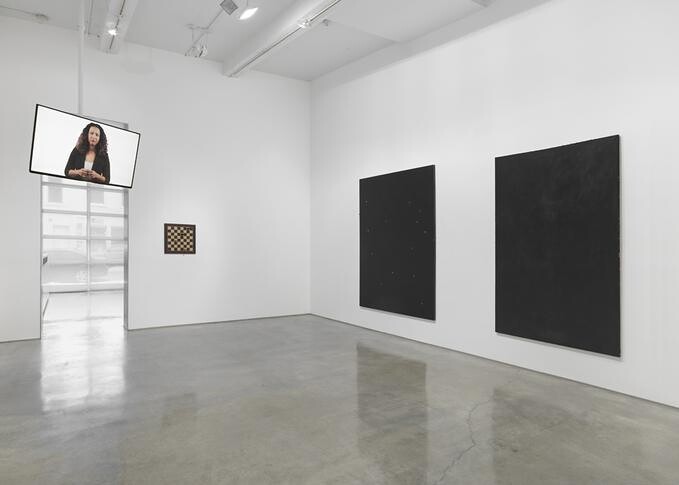
At the center of Claire Fontaine’s new show, “Stop Seeking Approval,” is a series of monochrome paintings, in gray, a burnt red, and black. They have been painted using anti-climb paint, their colors dictated by price and availability. Anti-climb paint never dries, so in addition to making its object hard to climb, anyone who touches it is marked as having done so. These paintings are permanently wet.
They are also paintings, the classic objects of desire for the collecting class, and so the temptation is to read Fontaine’s no-climb monochromes as the artist getting defensive about making objects for the purpose of exchange. And the great pleasure of “Stop Seeking Approval” is that so much of the show works as a personal expression of the ready-made artist, in addition to the host of conceptual and political levels we’d expect. The title, for example, could just as easily refer to:
1) A message from the artist to herself. 2) An excerpt from Untitled (Why your psychology sucks) (all works 2015), the re-fabricated self-help video, alternately seductive and ridiculous, that greets us on a monitor as we enter. 3) A commentary on the political strategy of Syriza. 4) A hypothetical slogan for Claire Fontaine™. …
February 14, 2014 – Review
“Bad Conscience”
Jennifer Piejko
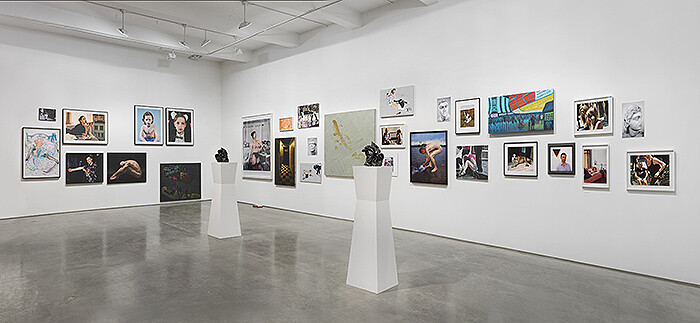
Over the decades, John Miller has produced a body of work that is semi-ambiguous in concept, yet is—in terms of deadpan humor and wry observation—unwaveringly his own. In the 1980s, he made pieces that appeared to be caked in human waste, like paintings with brown splotches and appropriated objects covered with brown plaster; in recent years, he has gilded junk and composed melodramatic portrayals of reality-television-show stars—all of which play to the middlebrow taste and artifice that he critiques. However, Miller’s latest endeavor at Metro Pictures, “Bad Conscience,” an expansive and varied group show he has curated, suggests that it might simply be impossible for his practice to be represented by his artwork alone.
Illustrating the work of a significant number of his previous collaborators, sixty-five works are spread across the gallery’s immense rooms, most of them clustered in conceptually interlaced compositions. One constellation of banal images, richly treated in oil paint—Caleb Considine’s Hairdryer (2013) and Marilyn Minter’s Paper Curls and Untitled (Porcelain Photo) (both 1976)—are hung opposite from a mix of photographs either weighed down with self-conscious unease or unmoored by their subjects’ reckless oblivion. Adjacent is a wall that includes Walter Robinson’s Impression Cheeseburger (2012) and Greg Parma Smith’s …
February 28, 2013 – Review
Trevor Paglen
Stephen Squibb

Politics is similar to art in that both are often reduced to questions of representation. The question of who or what is being represented by who or what; the question of whether this representation is legitimate or effective; and most importantly, the belief that the most important work is simply a redistribution of representation: a redeployment of our attention to where it was missing—or merely adding a seat at an already existing table. The limitations of this approach become evident if the table is deemed unsatisfactory. In politics, the re-designers of that table are called “radicals” (from the Latin radicalis, or “roots”), whereas in art, there is a parallel to work we call abstract. Thus, the work of the imaginary is especially clear and obvious in both radical politics and abstract art—though, and this is important, it is not absent from either non-abstract art or un-radical politics, merely harder to locate.
I would like to wager that when history remembers Trevor Paglen as one of the important artists of our time it will be because of the way that his work summons precisely this set of relationships: between abstraction and representation, politics and art, image and idea. If this claim seems …
July 13, 2012 – Review
"Dogma"
Adam Kleinman
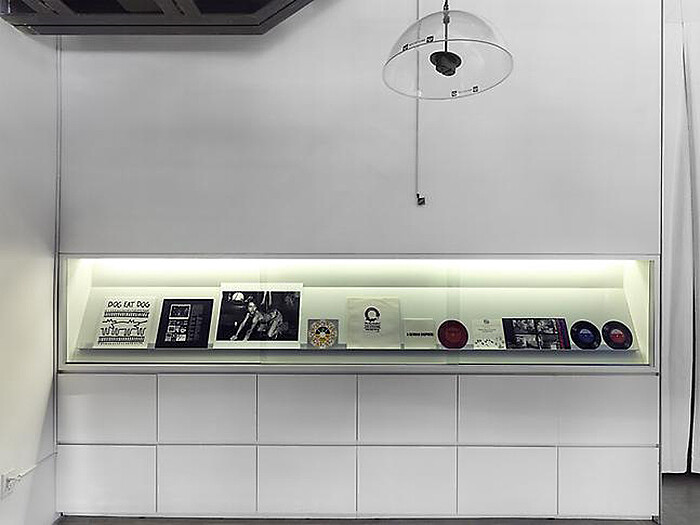
Although dogs are “man’s best friend,” no other species has been as manipulated by humans—a strange take on friendship indeed. This tenuous power play between love and dominance lies at the heart of “Dogma,” Metro Pictures’s summer group show organized around the very relationships and allusions “forged between mankind and dogs” by Swiss Institute Director Gianni Jetzer.
And just to let you know who’s boss, Dustin Pittman’s NOW I WANT TO BE YOUR DOG, IGGY POP 1970 (1970), a black-and-white photograph of the singer wearing a studded collar while offering himself up on all fours, smacks the visitor on the nose upon entry. Joining this image are various other music-related references set in a shared vitrine, the strongest pairing of which is a Keith Haring band poster featuring a conga line of dogs biting other dogs’ asses next to the adage “DOG EAT DOG.” Slipping away from this scintillating juxtaposition of psycho-sexual innuendos are several record albums, namely, Cat Stevens’s Was Dog a Doughnut (1977), an early electro-dance track featuring barking dog sounds complimented by an image of a wiener dog-cum-ouroboros on it’s sleeve; a collection of sound effects edited by Jack Goldstein, most importantly the barks of German Shepherds; and …
November 27, 2011 – Review
Claire Fontaine’s “Working Together”
Stephen Squibb
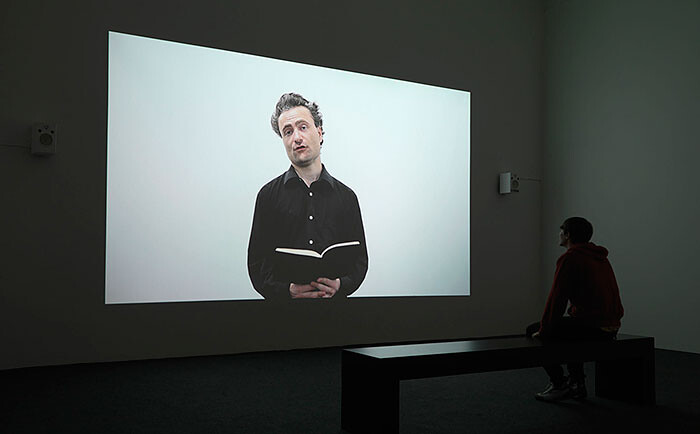
Claire Fontaine’s migration from Reena Spaulings to Metro Pictures for “Working Together,” her first show in Chelsea, pressurizes her concept of the ready-made artist. If this idea was once experimental, now it is deployed in the field at large. Fontaine has described the ready-made artist as referring, “to the reproducibility of artists during… an era that has been qualified as post-Fordist, one in which on-demand has replaced stock. The only goods still produced on an assembly line—that of the education system—without knowing for whom, nor why, are workers, including artists.”[1] Fontaine’s own name is taken from a popular brand of French notebooks and stationary, and those responsible for assembling the work that appears with her signature refer to themselves as her assistants.
It is in this sense that The Assistants (2011) one of two videos on display in “Working Together” —in which a poet reads a Giorgio Agamben text of the same name—can be called a self-portrait. The other, Situations (2011), an unsettling presentation of street-fighting pedagogy, is more in-keeping with the found quality of the rest of the work and is emblematic of the show’s success. In other words, having declared the artist a ready-made, Fontaine could have preceded apace …